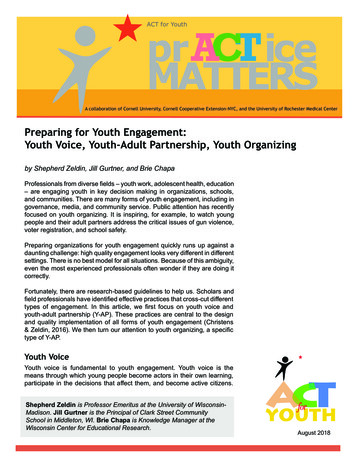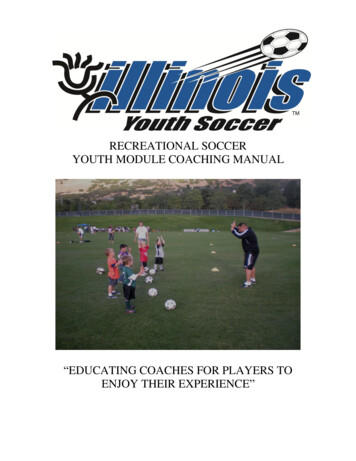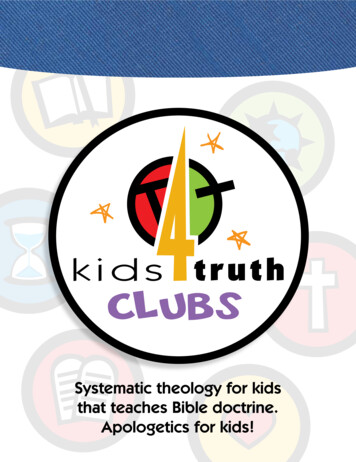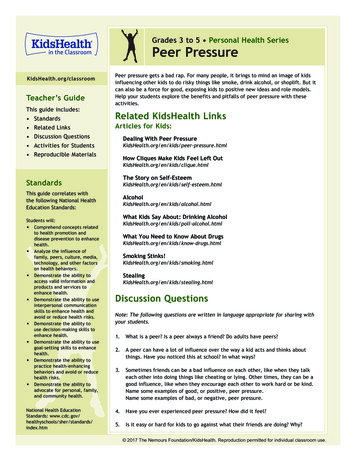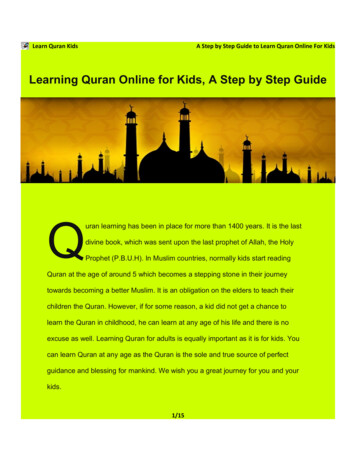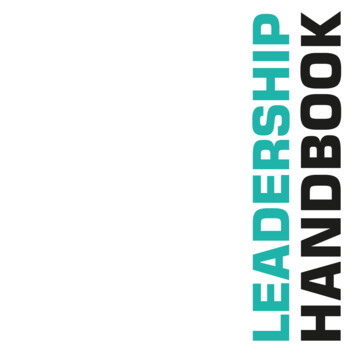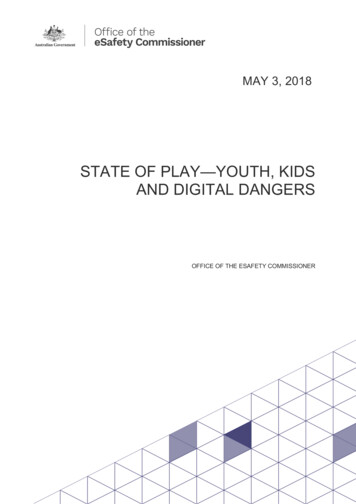
Transcription
MAY 3, 2018STATE OF PLAY—YOUTH, KIDSAND DIGITAL DANGERSOFFICE OF THE ESAFETY COMMISSIONER
2ContentsResearch@eSafety. 3Data sources . 3Other research relating to young people . 3Introduction. 4Young people aged 8–17 . 4Definition of ‘kids’ and ‘teens’ . 4Adults aged 18 years and over . 4Social media usage. 7The upside and downside of social media . 7Take up of social media services . 8Managing social media privacy. 9Contact with strangers. 12Making friends with people they first met online. 13Information shared online. 15Password sharing. 16Negative online experiences. 20Impacts of negative online experiences on young people. 22Actions taken after a negative online experience. 24Adult negative experiences online. 25Young people as bystanders. 27Bystander responses . 28Young people reporting behaving badly online. 29Conclusion. 31References. 32eSafety.gov.au
3Research@eSafetyUnder Section 15 of the Enhancing Online Safety Act 2015, the Office of the eSafetyCommissioner (the Office) has the following research functions, to: support, encourage, conduct and evaluate research about online safety for Australians collect, analyse, interpret and disseminate information relating to online safety publish reports and papers relating to online safety for Australians.The Office’s research program is underpinned by four key themes including:1. tracking trends2. supporting the development of Office resources and programs3. inter-agency and international co-operation4. program and resource evaluation.This research fits under themes 1 and 2.Data sourcesData in this report about young people is drawn from the Office’s 2017 Youth DigitalParticipation Survey. This survey comprised a random sample of more than 3,000 youngpeople in Australia aged 8–17 and collected information on their online safety experiencesand behaviours in the 12 months to June 2017.Data on the online experiences of adults was taken from a survey of 500 people aged 18years and over, exploring their personal experiences in the 12 months to December 2017.Desk research was also conducted to provide additional context for key survey findings.Readers should note that the desk research is not exhaustive, with citations included toprovide additional examples.Other research relating to young peopleA range of other research reports have also been published by the Office drawing on datafrom the 2017 Youth Digital Participation survey. These include: Young people and sexting—attitudes and behaviours, December 14 2017 State of play—youth and online gaming in Australia, March 5 2018.Research published by the Office is available online at esafety.gov.au/about-theoffice/research-libraryFor any enquiries relating to the Office research program, please contactresearch@esafety.gov.aueSafety.gov.au
4IntroductionYoung people aged 8–17The internet is an integral part of the digital lives of young people in Australia, with mostgoing online regularly to learn, keep in touch with friends and have fun. Born into analready web-connected world, kids and teens have been using the internet for the majorityof their lives and, for them, not being online is simply unthinkable and unavoidable.However, engaging online can be confronting in terms of having to deal with thebehaviours of others who may not necessarily value or relate to the need for respectonline. This report examines the online experiences of young people using of a number ofkey questions: What actions do young people take to manage their social media? What level of contact do they have with strangers online? How significant is the sharing of personal information online with strangers? What are their attitudes and behaviours towards sharing their personal passwords andin what circumstances does this occur? What are their negative experiences online and how do they deal with them? What are impacts of these experiences and what can be learnt from them?Definition of ‘kids’ and ‘teens’For this report, when examining the online experiences and behaviours of kids and teens,the age ranges of 8–12 have been used for kids, and 13–17 for teens. This is to betteralign the analysis in this report with recommended user age on the majority of social mediasites.Adults aged 18 years and overWhile this report seeks to focus on the online experiences and behaviours of youngpeople, it is important to ask the question: Are the ‘bad things’ that happen onlinepredominantly confined to the young?Adults, particularly young adults, are just as active online as young people in Australia. Ifyoung people and adults are experiencing similar negative experiences this has broaderimplications for trust and confidence in digital society. Findings that show this would havea range of implications about the need to build digital resilience throughout life.eSafety.gov.au
5Key findingsThis report highlights a number of key themes in relation to the online challengesfacing young people age 8–17:Ø They are exposed to a wide range of issues online from unwanted contact tobullying and deal with these issues in a range of ways.Ø While negative experiences can be hurtful, young people also report positiveoutcomes from these experiences in terms of increased awareness of online risksand ways of dealing with issues when they arise.Ø Young people are not alone in having to deal with the unpleasant aspects of onlineparticipation with adults also experiencing similar challenges. This is a reflection ofthe importance of ongoing learning to build digital resilience and respect online.More detailed findings:Approximately 68% of young social media users manage and curate their social mediaprofiles in a range of ways. Specifically: 46% blocked or unfriended someone, 46% increased privacy settings, 43%ensured location details were not automatically set and 36% and 22% respectivelyremoved comments they, or others, had made.Young social media users encounter a variety of negative experiences onlineincluding: being contacted by strangers/someone they did not know, 25% being left out by others, 21% having mean things said about them/called names, 19% receiving repeated unwanted online messages from someone, 13% having lies/rumours spread about them, 13%.Young people more often use informal channels to deal with online issues including: telling a family member—parents (55%), siblings (15%) blocking the offending social media account, 37% telling friends, 28% reporting it to the website or social media company, 12%.Nearly 6 in 10 respondents who reported a negative experience online in the 12 monthassessment period identified emotional and/or psychological impacts as a result,reporting: I did not feel good about myself, 36% I felt anger, fear, helpless, without power, 35% I felt left out/I lost some of my friends, 24% My reputation was damaged, 11% I didn’t feel close to my family and/or friends, 9%.A similar proportion also reported positive outcomes from these experiences: I became more aware of online risks, 40% I became more aware of who my real friends are, 33% I learnt to use the internet in a more balanced way, 23% I developed a greater understanding of my own behaviour online, 19%eSafety.gov.au
6 I became more able to overcome problems that I experienced online, 14%.Young people also report behaving badly towards their peers online: In the 12 months, 20% of young people reported that they had behaved negativelytowards others online with the range of behaviours including calling someonenames, deliberately excluding people, spreading lies or rumours, etc. The overwhelming majority of these young people (9 in 10) also reported havingnegative online experiences themselves during the same period.eSafety.gov.au
7Social media usageMaking and maintaining social connections are a central feature of growing up andbecoming an adult (Abrams, Weick, Thomas, Colbe, & Franklin, 2011). For young people,this is increasingly achieved through online engagement. As digital natives, social mediaand digital technologies have become an integral aspect of the culture, education and livedexperience of young people today (Allen, Ryan, Gray, McInerney, & Waters, 2014).The upside and downside of social mediaPrevious research published by the Office shows that young people have what can bedescribed as a ‘love-hate’ relationship with social media and, as Table 1 shows, recogniseits upside and downside.Table 1: Young people’s perspectives on the upside and downside of social mediaUpside ( )Downside (-)o Keeping connected to friends ando Nasty comments—45%family—76%o Entertainment—69%o Inappropriate or hurtful content—36%o Keeping up to date—45%o Nothing—30%o Planning social life—30%o Feeling they have to keep checking it—23%o Self-expression—26%o Fear of missing out—18%Base Social media users aged 8–17. Source: Research insights: Young and social online, Office of the eSafety Commissioner, 2016.(Office of the eSafety Commissioner, 2016)Office research is further supported by other studies which have shown that the ubiquitousnature in which young people use social media gives them greater opportunities toconnect, communicate and interact with each other and improve their technical skills(Davis, 2012) (Abrams et al., 2011) (O'Keeffe & Clarke-Pearson, 2011). For example,there is evidence that social media has: helped young people broaden their friendship groups by allowing them to connect withpeers regardless of their physical location or time of day (Davis, 2012) allowed lonely students to feel less shy and more comfortable about chatting onlinerather than face-to-face and feel that they belonged to a group (Bonetti, Campbell, &Gilmore, 2010) satisfied young people’s social identity needs and fed their efforts to develop healthyand positive self-images (Gajaria, Yeung, Goodale, & Charach, 2011) (Barker, 2012).However, there is also recognition that social media has contributed toward a range ofnegative consequences. A number of media reports have reflected on the ‘compulsive’relationship people can develop with social media and its platform features (Lewis , 2017)(Hern , 2018).These concerns have also been raised in academic literature. For example,while not yet recognised as a disorder, recent reviews of social network addiction studieshave found that between 2% and 10% of those surveyed were problematic users of socialmedia (Marino, Gini, Vieno, & Spada, 2018). It was also the case that within this group,there was a positive correlation with psychological distress, including anxiety anddepression as well as a small negative correlation between social media use andpsychological well-being (Marino et al., 2018).eSafety.gov.au
8Adverse consequences of social media use have also been observed in some studies thathave measured the academic performance of users. These have found a correlationbetween increased social media use and procrastination leading to poorer academicperformance (Jacobsen & Forste, 2011) (Junco, 2012) (Panek, 2013) (Meier, Reinecke, &Meltzer, 2016).Beyond the compulsive tendencies of social media and its effects on academicperformance, the fact that young people are still mastering tasks such as impulse control,emotional regulation and the assessment of consequences and risks (Steinberg, 2008)also means that they face a number of other issues stemming from having access to socialmedia and being online (Lareki, Martinez de Morentin, Altuna, & Amenabar, 2017). Somehave already been explored by the Office such as sexting (SWGFL/UK Safer InternetCentre, University of Plymouth, Netsafe, Office of the eSafety Commissioner, 2017) andothers form part of the present report—e.g. negative online experiences, handling personaldata and online safety. Further risks reported include grooming; social isolation; accessand exposure to inappropriate content; identity theft and exposure to online marketing.Take up of social media servicesOur research highlighted what social media services young people used in Australia. Incases such as the use of YouTube, having a profile is not necessary to gain access tocontent. From this perspective, use of social media by kids and young people in Australiais almost ubiquitous with a broad range of services being accessed (Table 2). Youngpeople make use of multiple social media services, on average 3 for kids and 5 for teens.Considering social media sites individually, Table 2 shows the social media services usedby young people in Australia in the year to June 2017. The table also highlights thevariation in popularity of these services among key age ranges which closely reflectrecommended cut-off ages for use of particular social media services.Table 2: Social media services used in the 12 months to June 2017YouTubeFacebookInstagramSnapchatGoogle omething 3%7%8%15%2%3%2%6%1%2%1%Less than s than 1%eSafety.gov.au
9YouTube was used by consistently high numbers of both kids and teens. For the othersites and services, there was an expected difference between the patronage of kids andteenagers. As young people age they are more likely to go about expanding their socialidentity online and meet requirements for setting up user profiles to access these services.Table 2 shows that around 26% of those aged 8–12 use certain social media sites(Facebook, Instagram, Snapchat and Skype) despite the age restrictions these platformsplace as part of their terms of use1. These restrictions have been established in order tocomply with the Children’s Online Privacy Protection Act—a US law prohibiting websitesfrom collecting information of children younger than 13 years without parental permission.Our findings therefore show that parents and guardians have an important role to play inassessing a child’s maturity, agency and ability to deal with the content and contacts thatthey may be exposed to while online.The Office’s survey also confirmed previous findings around the gender differences insocial media use. Lenhart et al. (2015), for example, reported that girls in the United Stateswere more likely than boys to participate in visually oriented social media platforms. In anAustralian context, our findings reflect this too, with girls more likely to use sites likeInstagram (52% vs 42% for boys), Snapchat (53% vs 39% for boys) and Pinterest (23% vs8% for boys). Other popular social media sites among girls include Musical.ly (18% vs 6%for boys) and Tumblr (12% vs 4% for boys). Boys on the other hand were more likely touse sites such as YouTube (85% vs 81% of girls) and Reddit (8% vs 4% for girls).Managing social media privacyWhen people update their social media profiles, they are producing online repositories ofaccessible self-representations (De Wolf, Willaert, & Pierson, 2014). They do so despitebeing aware of the potential hazardous consequences linked to social comparison,jealousy and conflict (Osatuyi, Passerini, Ravarini, & Grandhi, 2018). Motivations to updatesocial media include pursuing visibility, affirmation and to avoid feeling alone or forgotten(Jeong & Kim, 2017). Straddling this line between risks and rewards, people on socialmedia engage in a range of strategies to maintain their privacy while online. Often thisinvolves managing a combination of privacy settings, considering social network size, andchosen degree of self-disclosure (Lankton, McKnight, & Tripp 2017). With a particularfocus on Facebook, Lankton et al. (2017) have found evidence that users can be classifiedaccording to the level of privacy settings on their social media profiles, as seen in Table 3.1Facebook, Instagram and Snapchat requires that users be aged 13 years and over. YouTube requires that accountholders be 18 years and over but those that are 13 and up can sign up with parental permission.eSafety.gov.au
10Table 3. Social media users by privacy settingsUser typeFeaturesDisclose veryThey have less restrictive privacy settings and are concernedpublicly and haveabout being accepted in the short term rather than about theirlarge networksprivacy.Disclose little andhave largenetworksThey have less restrictive privacy settings and engage in selfcensorship by posting benign information to avoid reputationaldamage.Disclose to a largenetworkThey use restrictive privacy settings selectively across differentsocial groups and are concerned with acquiring power, control andstatus.Disclose little tosmall networksThey use more privacy settings and use social media for reasonsother than making an impression or social connection. Theirpassive use of social media is more akin to content consumption.Academic literature has shown a number of factors to be associated with different privacymaintenance behaviours. These include: One’s privacy concerns: Feng & Xie (2014) found that a parent’s privacy concerns anda teenager’s increased social media use increased that young persons’ online privacyconcerns. The authors, along with Litt (2013), found that people with greater privacyconcerns engaged with more technological privacy tools than those that did not. One’s awareness of social network privacy features: Wisniewski, Knijnenburg, &Lipford (2017) confirmed that awareness of privacy features predicted their adoption.They showed that while those with greater expertise tended to use the most privacyfeatures, this was not always the case. Employing fewer protective strategies was aninformed decision for some of these users. In addition, social media novices also didnot always use the fewest or most basic privacy features. Instead, they were morelikely to seek out and use privacy mechanisms that accomplished specific goals suchas selectively sharing information. One’s experience on social network platforms: Litt (2013) found that accounting formotivational and background factors, those who most often used social network sites,were more likely to engage with more privacy tools. This was true for those that usedsocial networks several times a day compared to those that used them less often thanonce a week. Having experienced a prior privacy breach: Litt (2013) confirmed previous findingswhich found that those users that have had turbulent online experiences use moretechnological privacy tools than those who have not experienced regret or negativityonline. Moreover, Osatuyi et al.(2018) found that there were differences betweenpeople who had suffered a privacy breach and those who had not. The latter weremore likely to disclose more shallow information. Demographic factors: Feng and Xie (2014) found that girls and older teens implementmore privacy setting strategies than boys and younger teens. Litt (2013) also found thateSafety.gov.au
11males used a less diverse set of technological privacy tools than females even whenprivacy concerns and experience on social networking sites was controlled for.Excluding formal reporting to social media sites or schools and parents, our survey showsthat 68% of young people who use social media in Australia have tried to actively managetheir online privacy through privacy settings in the 12 month period. As Table 4 shows,young people’s social media use is reflected in a number of actions targeted towardsmanaging their online presence.Table 4. Actions taken to manage young people’s social media presenceActionBlocked people (including 'unfriending')Increased my privacy settingsSet up my account so that it does not automatically include my location on my postsDeleted comments that I have madeChanged my filter preferencesDeleted comments that others have made on my profileRemoved my name from photos that I have been tagged inReported someone to the social media company or another organisationReported someone to my school or my parentsNone of theseTotal46%43%36%22%21%21%16%13%12%31%While a large majority of young people actively manage their online digital presence, oursurvey also shows that there are some key differences in terms of the degree to whichdifferent age groups do so. Figure 1 highlights the differences in how kids and teensmanage their online social media presence.Figure 1: Social media management by ageReported someone to my school or my parentsReported someone to the social media company oranother organisationRemoved my name from photos that I have beentagged inDeleted comments that others have made on myprofile11%13%7%18%9%24%11%31%12%30%Changed my filter preferencesTeens (13-17)12%32%Deleted comments that I have madeNone of theseSet up my account so that it does not automaticallyinclude my location on my posts48%13%24%29%Increased my privacy settings28%Blocked people (including 'unfriending')Kids (8-12)49%57%64%Base Young people using social media.eSafety.gov.au
12Nearly half of kids between the ages of 8 and 12 have not actively managed their onlinepresence via social media. In addition, kids were significantly less likely than teens toundertake a number of tasks in order to stay safe online. These include blocking people(28% vs 64% of teenagers) as well as untagging themselves from photos shared by others(9% vs 24%). Reflecting previous findings around privacy management on social mediasites, there were also differences between boys and girls. Figure 2 shows that girls aresignificantly more vigilant than boys in managing their online presence.Figure 2. Social media management by genderReported someone to my schools or my parentsReported someone to the social media company or anotherorganisationRemoved my name from photos that I have been tagged inDeleted comments that others have made on my profileChanged my filter preferencesDeleted comments that I have madeNone of theseSet up my account so that it does not automatically includemy location on my postsIncreased my privacy settingsBlocked people (including ys24%20%28%34%42%31%47%39%42%50%Base Young people using social media.Young people in special needs groups such as those with a disability and those fromCulturally and Linguistically Diverse (CALD) backgrounds are more active in theirmanagement of social media than the general population of young people. Around 72% ofpeople identifying in both of these groups had actively managed their social mediapresence compared to around 67% for other social media users.Contact with strangersYoung peoples’ online presence and tailored self-representation across multiple socialnetworking sites enables them to connect with others and broaden their social circle toinclude online strangers. Despite the fact that most of these interactions are harmless,they are often perceived as risky by both the public and researchers alike (Cernikova,Dedkova, & Smahel, 2018). An overly dominant focus on risky interactions, such asunwelcomed and potentially abusive adult contact overlooks the many other possible waysthat young people can meet a stranger online. There are a number of services that youngpeople use regularly where they get in touch with unknown people. These include socialeSafety.gov.au
13networking sites, online games, video sharing sites as well as blogging and discussionsites (Cernikova et al., 2018).Reflecting this commonality, our survey findings show that around 38% of young people inAustralia aged 8 to 17 had used the internet to talk or chat to someone that they did notpreviously know in the 12 months to June 2017. As Figure 3 shows, boys weresignificantly more likely to engage in this type of behaviour than girls.Figure 3: Talking to strangers online by gender62%55%42%Yes34%NoDon't know4%4%BoysGirlsThis aspect of young peoples’ online presence was significantly more common in olderrespondents—with teens almost twice as likely as kids to talk to a stranger online. AsFigure 4 shows, around one in two teens (50%) talked to a stranger online compared tojust over one in four of all kids (27%).Figure 4: Talking to strangers online by age70%50%46%YesNo27%Don't know4%3%KidsTeensEngaging in online conversations with strangers differed for young people coming from aCALD background or those with a disability. The survey showed that around 37% of youngpeople who were not from a CALD background or did not have a disability had talked tosomeone they did not know online. In comparison, around half (50%) of those with adisability and 44% of those from a CALD background reported that they had done so.Making friends with people they first met onlineWith increasing intensity of interactions, young people can turn initial exchanges withonline strangers into real world and online friendships (Cernikova et al., 2018). Qualitativestudies have shown that as they move from non-verbal interactions to initial contact,communication and face-to-face meetings, young people often evaluate their interactionswith online strangers to see if they are going to be problematic, and need to be stopped.eSafety.gov.au
14In doing so, they generally look for clues that suggest similarity, such as mutualfriendships, and engage in conversations that are not perceived as inappropriate(Cernikova, et al., 2018).Overall, our survey findings show that around 24% of Australian young people had madefriends with someone they met on the internet in the past year. While there was noobservable difference between boys and girls, teens were more than twice as likely as kidsto make online friends (34% of teens vs 14% of kids). Figure 5 highlights how makingfriends with people online increases with age.Figure 5: Young people making friends with people they first met online44%% of online eIt was also the case that those from a CALD background as well as those with a disabilitydemonstrated a significantly greater preference for making friends online in comparison toother groups (Figure 6). A total of 35% of those with a disability had made friends withsomeone they had first met online along with 31% of those from a CALD background.Figure 6: Making friends with people they first met online by CALD and disability status75%74%66%62%Yes35%31%No23%22%3%Youth from non CALDbackgrounds4%Youth from CALDbackgroundsDon't know3%Youth without adisability3%Youth with a disabilityeSafety.gov.au
15Information shared onlineOnline communication promotes self-disclosure (Kashian, Jang, Yun Shin, Dai, & Walther,2017). When engaging online, people have been shown to use more interactive strategies—self disclosure and question asking—to reduce uncertainty about others than those whouse face-to-face communication (Schouten, Valkenburg, & Peter, 2009) (Tidwell &Walther, 2002). In addition, people perceive the same self-disclosure to be more intimatewhen it is received online than when it is received face-to-face (Jian, Bazarova, &Hancock, 2013). Unprompted, people also display relatively personal information on datingand social media profiles like political and religious views, age, work history andhobbies.(Nosko, Wood, & Molema, 2010). Results from our survey (Figure 7) show thatthe type of information young people shared with people they have not met in personincluded general, personal and not surprisingly, fake information.Figure 7: Information shared online by young people with those they’ve not met in personMy home phone numberMy home addressSomething that shows my school uniformPersonalMy mobile phone numberMy email addressMy birthdayThe name of my school1%1%2%2%3%14%3%3%Something else4%My full name4%Something that shows my face5%GeneralFakeMy real ageA fake ageMy fake nameMy hobbiesThings I like and things I dislike8%5%10%9%13%19%16%Our findings point to a number of demographic differences in the type of information beingshared online. A slightly higher proportion of girls revealed personal information (15% vs13% for boys) and boys revealed fake information (12% vs 8% for girls). In addition, teenswere more likely to disclose information about themselves than kids: general information—26% vs 12% for kids personal information—19% vs 9% for kids fake information—12% vs 9% for kids.Greater self-disclosure was also a trademark of young people from certain groups such asthose from a CALD background or those with a disability. As evidenced by Figure 8, ahigher proportion of these groups shared general, personal and fake information than theirrespective counterparts.eSafety.gov.au
16Figure 8 Sharing information by CALD and disability status29%23%19%19%17%14%13%12%10%
the importance of ongoing learning to build digital resilience and respect online. More detailed findings: Approximately 68% of young social media users manage and curate their social media profiles in a range of ways. Specifically: 46% blocked or unfriended someone, 46% increased privacy settings, 43%
